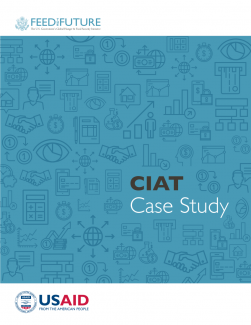This case study describes the data-driven agronomy work led by the International Center for Tropical Agriculture (CIAT), a CGIAR center headquartered in Cali, Colombia. It is part of a series highlighting the integration of digital technologies into agricultural programs. Each case study examines different approaches to adoption and how digital tools impact organizational culture, operations, and programs.
In 2008, CIAT began exploring a new approach to use big data tools to analyze information and help farmers make better on-farm decisions that lead to improved agricultural outcomes. This approach, referred to as data-driven agronomy, enhances agronomy through increased use of observational information, data mining, and contextual information to provide farmers with tailored recommendations about what to plant, when, and how to manage crops. CIAT has been using the approach over the last ten years with a range of partners across Latin America. This case study focused on CIAT’s experiences in Colombia working with the rice, fruit, and maize growers’ associations – Fedearroz, Asohofrucol, and Fenalce, respectively – and the Ministry of Agriculture and Rural Development in the region of Pereira.
CIAT’s data-driven agronomy work has three distinct phases: data collection, data analysis, and knowledge management.
DATA COLLECTION:
Data-driven agronomy requires multiple types of data which are not always publicly available or in a format useful for analysis. Datasets are aggregated from existing sources including open datasets, experimental data, and partners’ historical data, and are complemented by new data. This section describes CIAT’s experiences with gaining access to data from its government and private partners. It also highlights the challenges associated with aggregating datasets in terms of data management, entry, and cleaning. Capacity building in terms of data collection was important during this phase to ensure data quality and sustain the analytical tools in Colombia after the projects with CIAT end.
DATA ANALYSIS:
Data-driven agronomy complements traditional controlled experiments by analyzing observational data that captures the soil and climate diversity among farmers’ fields. Through various data mining and machine learning techniques, CIAT can examine multiple types of data to reveal patterns across crop varieties, climatic conditions, and location to identify optimal site-specific management practices and cultivars. These recommendations are reviewed and validated by an interdisciplinary team of data scientists, agronomists, and anthropologists.
KNOWLEDGE MANAGEMENT:
Data-driven agronomy leads to improved outcomes when model outputs are converted into relevant, understandable, and actionable information that is disseminated through accessible and trustworthy channels. While CIAT is well-positioned to assume the lead research role, the growers’ associations and government partners are better positioned to engage farmers. CIAT coached partner staff on interpreting information to ensure that recommendations were made with an understanding of the accuracy and variation of the models. In some projects, they built online tools to provide farmers and technicians with data about their specific farms. More recently, under CGIAR, CIAT established local committees through which farmers, alongside representatives from the private sector, research organizations, and technicians interpret climate, weather, and observational data to identify specific adaptation measures for adoption.
Digital agriculture advances agricultural outcomes by driving greater financial inclusion, more precise agriculture, better data collection and analytics, and more effective information dissemination. Data-driven agronomy leads to impacts that contribute to these outcomes in three ways:
- Using information to improve crop management decisions. Farmers receive better information for evidence-based decisions, leading to more precise and more productive agriculture. In one case, CIAT and Fedearroz predicted a dry spell and recommended farmers plant later than usual. This led to farmers avoiding crop losses valued at over USD 3.6 million.
- Improving the services and credibility of farmer-serving organizations. Through the collaboration with CIAT, these organizations improve their data collection and analysis skills. This enables them to improve the quality and accuracy of agronomic recommendations provided to their farmer members.
- Expanding the analytical avenues for agricultural research. Data-driven agronomy leverages observational data from farmers and data mining techniques to complement conventional agronomic research and achieve improved yields. CIAT leads this work within the CGIAR and has successfully scaled the approach through partnerships with the Latin American Fund for Irrigated Rice, the Government of Honduras, and the National Agricultural Technology Institute in Argentina.
The case study concludes by highlighting valuable lessons for organizations wishing to pursue similar digital integration.

